人教版七年级英语上册各单元知识点总结
- 格式:docx
- 大小:237.23 KB
- 文档页数:20
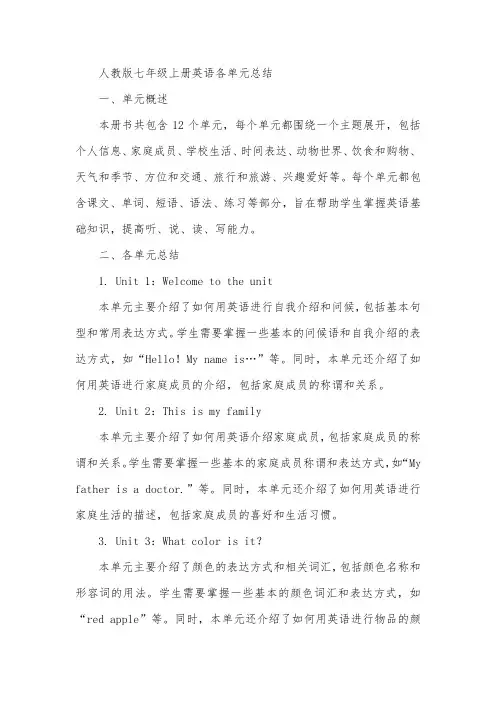
人教版七年级上册英语各单元总结一、单元概述本册书共包含12个单元,每个单元都围绕一个主题展开,包括个人信息、家庭成员、学校生活、时间表达、动物世界、饮食和购物、天气和季节、方位和交通、旅行和旅游、兴趣爱好等。
每个单元都包含课文、单词、短语、语法、练习等部分,旨在帮助学生掌握英语基础知识,提高听、说、读、写能力。
二、各单元总结1. Unit 1:Welcome to the unit本单元主要介绍了如何用英语进行自我介绍和问候,包括基本句型和常用表达方式。
学生需要掌握一些基本的问候语和自我介绍的表达方式,如“Hello!My name is…”等。
同时,本单元还介绍了如何用英语进行家庭成员的介绍,包括家庭成员的称谓和关系。
2. Unit 2:This is my family本单元主要介绍了如何用英语介绍家庭成员,包括家庭成员的称谓和关系。
学生需要掌握一些基本的家庭成员称谓和表达方式,如“My father is a doctor.”等。
同时,本单元还介绍了如何用英语进行家庭生活的描述,包括家庭成员的喜好和生活习惯。
3. Unit 3:What color is it?本单元主要介绍了颜色的表达方式和相关词汇,包括颜色名称和形容词的用法。
学生需要掌握一些基本的颜色词汇和表达方式,如“red apple”等。
同时,本单元还介绍了如何用英语进行物品的颜色描述和询问。
4. Unit 4:Where's my backpack?本单元主要介绍了如何用英语描述物品的位置和方位关系,包括介词的用法。
学生需要掌握一些基本的方位介词和表达方式,如“on the table”等。
同时,本单元还介绍了如何用英语进行物品位置的询问和描述。
5. Unit 5:Do you have a soccer ball?本单元主要介绍了如何用英语进行体育用品的描述和询问,包括相关词汇和表达方式。
学生需要掌握一些基本的体育用品词汇和表达方式,如“soccer ball”等。
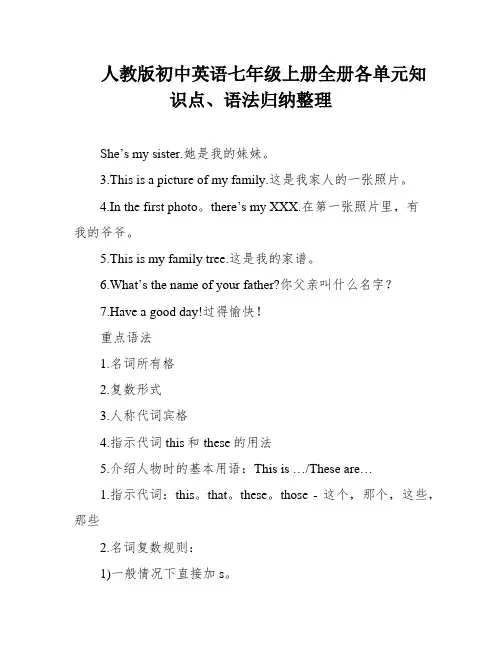
人教版初中英语七年级上册全册各单元知识点、语法归纳整理She’s my sister.她是我的妹妹。
3.This is a picture of my family.这是我家人的一张照片。
4.In the first photo。
there’s my XXX.在第一张照片里,有我的爷爷。
5.This is my family tree.这是我的家谱。
6.What’s the name of your father?你父亲叫什么名字?7.Have a good day!过得愉快!重点语法1.名词所有格2.复数形式3.人称代词宾格4.指示代词this和these的用法5.介绍人物时的基本用语:This is …/These are…1.指示代词:this。
that。
these。
those - 这个,那个,这些,那些2.名词复数规则:1)一般情况下直接加s。
2)以s,x,sh,ch结尾的加es。
3)以辅音字母加y结尾的将y变i再加es。
4)以o结尾的加s或es。
(有生命+es物生命加s)5)以f/fe结尾的名词,先将f/fv变成v再加es。
3.人称代词:I。
he。
she。
it和they - 我,他,她,它,他们/她们/它们4.重点短语:Is this/that your。
- 这/那是你的……吗?Yes。
it is。
/ No。
it isn't。
- 是的,是它。
/ 不,不是。
XXX。
- 这些/那些是我的……Here are。
- 这里有……This/That is my。
- 这/那是我的……Have a good day。
- 祝你玩得愉快!Excuse me for interrupting。
but could I ask you a n?Thank you very much.Could you please speak in English?Do you enjoy playing computer games?Have you checked in the lost and found case to see if your item is there?Please call 685-6034 to reach me.I lost my school ID card and need to find it.I need a set of pencils for my art class.Key XXX structures:Is that your school bag?No。
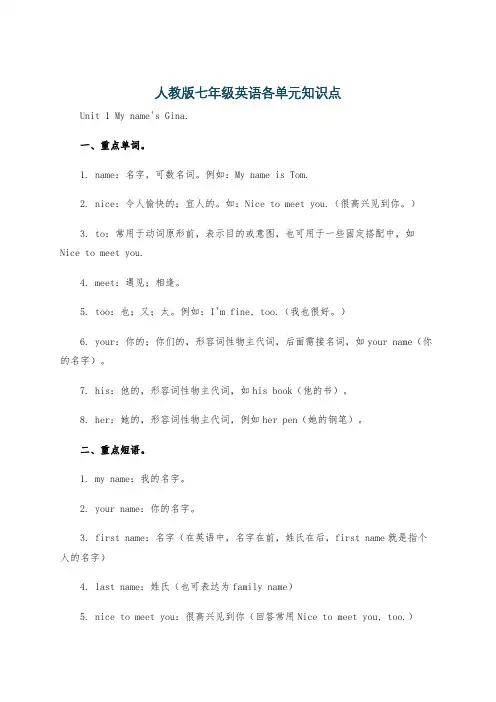
人教版七年级英语各单元知识点Unit 1 My name's Gina.一、重点单词。
1. name:名字,可数名词。
例如:My name is Tom.2. nice:令人愉快的;宜人的。
如:Nice to meet you.(很高兴见到你。
)3. to:常用于动词原形前,表示目的或意图,也可用于一些固定搭配中,如Nice to meet you.4. meet:遇见;相逢。
5. too:也;又;太。
例如:I'm fine, too.(我也很好。
)6. your:你的;你们的,形容词性物主代词,后面需接名词,如your name(你的名字)。
7. his:他的,形容词性物主代词,如his book(他的书)。
8. her:她的,形容词性物主代词,例如her pen(她的钢笔)。
二、重点短语。
1. my name:我的名字。
2. your name:你的名字。
3. first name:名字(在英语中,名字在前,姓氏在后,first name就是指个人的名字)4. last name:姓氏(也可表达为family name)5. nice to meet you:很高兴见到你(回答常用Nice to meet you, too.)三、重点句型。
1. —What's your name?(你叫什么名字?)—My name's Gina.(我的名字是吉娜。
)2. —Nice to meet you.(很高兴见到你。
)—Nice to meet you, too.(我也很高兴见到你。
)3. —What's his name?(他叫什么名字?)—His name's Tom.(他的名字是汤姆。
)4. —What's her name?(她叫什么名字?)—Her name's Mary.(她的名字是玛丽。
)Unit 2 This is my sister.一、重点单词。
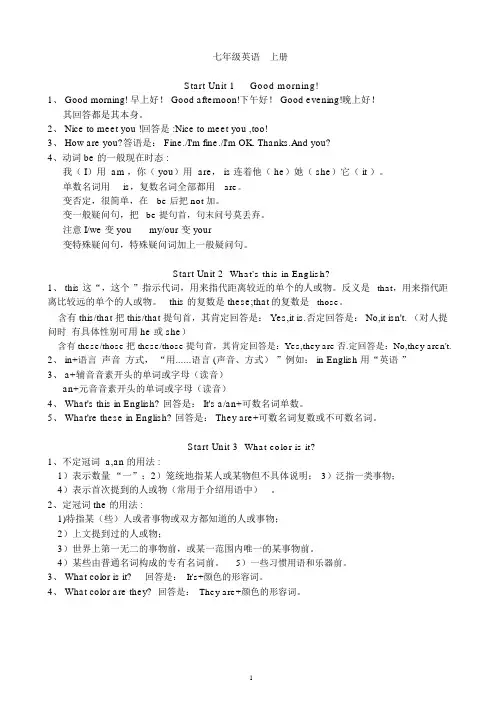
七年级英语上册Start Unit 1Good morning!1、 Good morning! 早上好! Good afternoon!下午好! Good evening!晚上好!其回答都是其本身。
2、 Nice to meet you !回答是 :Nice to meet you ,too!3、 How are you?答语是: Fine./I'm fine./I'm OK. Thanks.And you?4、动词 be 的一般现在时态 :我( I)用 am ,你( you)用 are, is 连着他( he)她( she)它( it )。
单数名词用is,复数名词全部都用are。
变否定,很简单,在be 后把 not 加。
变一般疑问句,把be 提句首,句末问号莫丢弃。
注意 I/we 变 you my/our 变 your变特殊疑问句,特殊疑问词加上一般疑问句。
Start Unit 2What's this in English?1、 this 这“,这个”指示代词,用来指代距离较近的单个的人或物。
反义是that,用来指代距离比较远的单个的人或物。
this 的复数是 these;that的复数是those。
含有 this/that 把 this/that 提句首,其肯定回答是: Yes,it is.否定回答是: No,it isn't. (对人提问时有具体性别可用 he 或 she)含有 these/those把 these/those提句首,其肯定回答是:Yes,they are否.定回答是:No,they aren't.2、 in+语言声音方式,“用......语言 (声音、方式)”例如: in English 用“英语”3、 a+辅音音素开头的单词或字母(读音)an+元音音素开头的单词或字母(读音)4、 What's this in English? 回答是: It's a/an+可数名词单数。
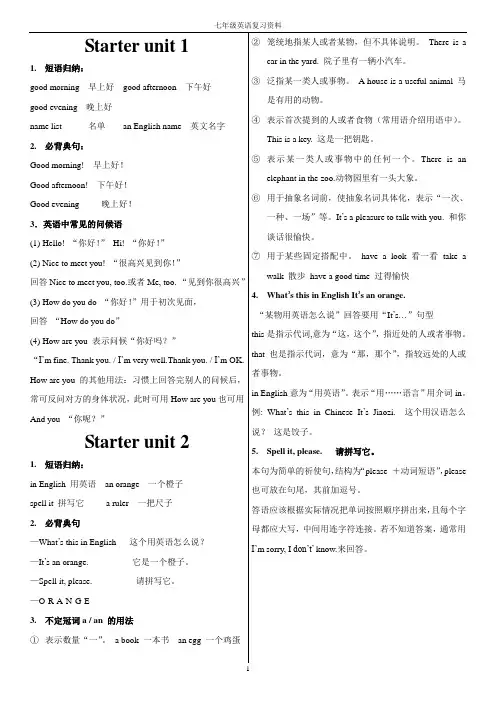
空间
form Monday to Friday 从周一到周五
form Beijing to Shanghai 从北京到上海
6.finish的用法
finish作不及物动词时,意为“完成;做好”
They start work early and finish late every day.他们每天开工早收工晚。
作及物动词,后接动词时,要用动名词形式,即finish doing sth. 表示“做完某事,
完成某事”
Jim usually finishes doing his homework before 8:00.吉姆通常在8点前做完作业。
7.thank sb for的用法:
thank sb for意为“因……而感谢某人”,for是介词,后接名词、代词或动名词,表感
谢的原因或内容。
Thank him for telling me. 谢谢他告诉我。
Thank you for helping with my English.多谢你帮我学英语。
8.for two hours的用法:
“for+一段时间”是介词短语,意为“……时间”,表示某事持续多长时间。
对其提问要用
how long
—How long will you stay in Beijing 你将在北京待多长时间?
—For about three days. 大约三天。
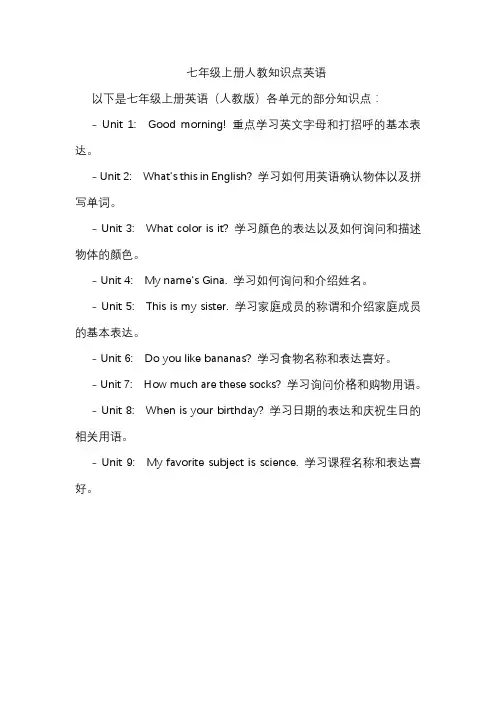
七年级上册人教知识点英语
以下是七年级上册英语(人教版)各单元的部分知识点:
- Unit 1: Good morning! 重点学习英文字母和打招呼的基本表达。
- Unit 2: What’s this in English? 学习如何用英语确认物体以及拼写单词。
- Unit 3: What color is it? 学习颜色的表达以及如何询问和描述物体的颜色。
- Unit 4: My name’s Gina. 学习如何询问和介绍姓名。
- Unit 5: This is my sister. 学习家庭成员的称谓和介绍家庭成员的基本表达。
- Unit 6: Do you like bananas? 学习食物名称和表达喜好。
- Unit 7: How much are these socks? 学习询问价格和购物用语。
- Unit 8: When is your birthday? 学习日期的表达和庆祝生日的相关用语。
- Unit 9: My favorite subject is science. 学习课程名称和表达喜好。
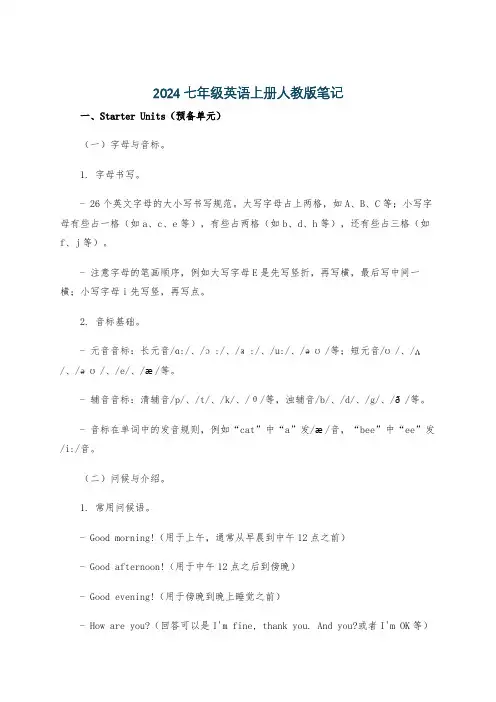
2024七年级英语上册人教版笔记一、Starter Units(预备单元)(一)字母与音标。
1. 字母书写。
- 26个英文字母的大小写书写规范。
大写字母占上两格,如A、B、C等;小写字母有些占一格(如a、c、e等),有些占两格(如b、d、h等),还有些占三格(如f、j等)。
- 注意字母的笔画顺序,例如大写字母E是先写竖折,再写横,最后写中间一横;小写字母i先写竖,再写点。
2. 音标基础。
- 元音音标:长元音/ɑ:/、/ɔ:/、/ɜ:/、/u:/、/əʊ/等;短元音/ʊ/、/ʌ/、/əʊ/、/e/、/æ/等。
- 辅音音标:清辅音/p/、/t/、/k/、/θ/等,浊辅音/b/、/d/、/g/、/ð/等。
- 音标在单词中的发音规则,例如“cat”中“a”发/æ/音,“bee”中“ee”发/i:/音。
(二)问候与介绍。
1. 常用问候语。
- Good morning!(用于上午,通常从早晨到中午12点之前)- Good afternoon!(用于中午12点之后到傍晚)- Good evening!(用于傍晚到晚上睡觉之前)- How are you?(回答可以是I'm fine, thank you. And you?或者I'm OK等)2. 自我介绍。
- My name's...(例如My name's Tom.)- I'm...(I'm a student.)二、Unit 1 My name's Gina.(一)重点单词。
1. name.- 名词,名字。
例如:What's your name?2. nice.3. to.- 在这里是不定式符号,如Nice to meet you中的to;也可作介词,表示“到……”,例如go to school。
4. meet.- 动词,遇见;会面。
例如:Nice to meet you.5. too.- 副词,也;太。
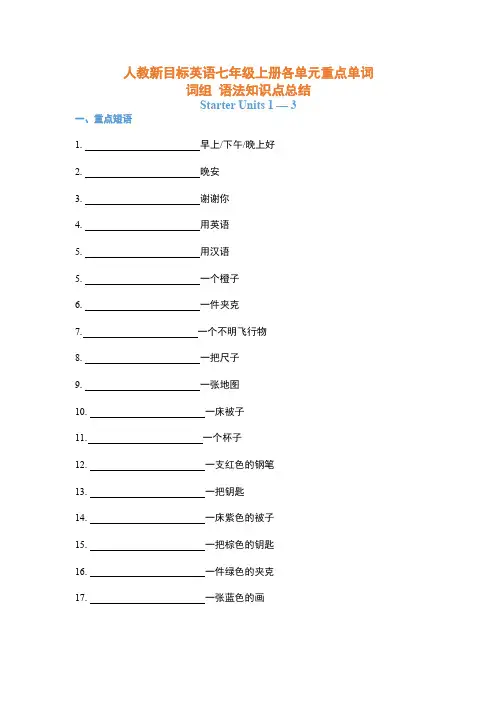
人教新目标英语七年级上册各单元重点单词词组语法知识点总结Starter Units 1 — 3一、重点短语1.早上/下午/晚上好2.晚安3.谢谢你4.用英语5.用汉语5.一个橙子6.一件夹克7.一个不明飞行物8.一把尺子9.一张地图10.一床被子11.一个杯子12.一支红色的钢笔13.一把钥匙14.一床紫色的被子15.一把棕色的钥匙16.一件绿色的夹克17.一张蓝色的画18.一把黄色的尺子19.一台黑白电视20.在早晨21.在下午22.在晚上23.在午夜二、重点句型1.你好吗?我很好,谢谢。
2.你呢?我很好3. Mike好吗?他很好。
4.- 这个用英语怎么说?- 一个橙子。
5.请拼写它。
6.它是什么颜色的?—红色的。
7.这个钥匙是黄色的8.我能说A、B、C 等字母了。
Unit 1 My name’s Gina.一、重点短语1.我的名字2.你的名字3.她的名字.4.他的名字5.他们的名字6.名字7.姓氏8.布朗女士布朗先生布朗夫人9.我的学生卡10.电话号码11.一张身份证12.我的朋友13.很高兴见到你.我也很高兴见到你14.中学15.在六中16.在中国17.0-10:二、重点句型1.— 你叫什么名字?一 . 我叫艾伦。
2.— 她叫什名字?-- 她叫玛丽3.他叫什名字?-- 他叫埃里克4.我朋友在中国。
5.— 你姓什么?—- 我姓格林。
6.—你的电话号码是多少?一我的电话号码是281-9176 8. — 你是海伦吗?—是的,我是。
11.— 他是杰克吗?—是的,他是。
不,他不是。
12.我的妈妈在中国Unit 2 This is my sister.—、重点短语1.一位叔叔2.一位阿姨3.我的祖父母4.他的父母5.我的家6.你的兄弟7.这两个女孩8.在第一张图片里9.在下一张图片里10.过得愉快谢谢,你也是11.我的全家福12.我家的一张照片13.我的狗的名字14.一张中国地图15.在我家16.两张照片二、重点句型1.这是我的朋友简。
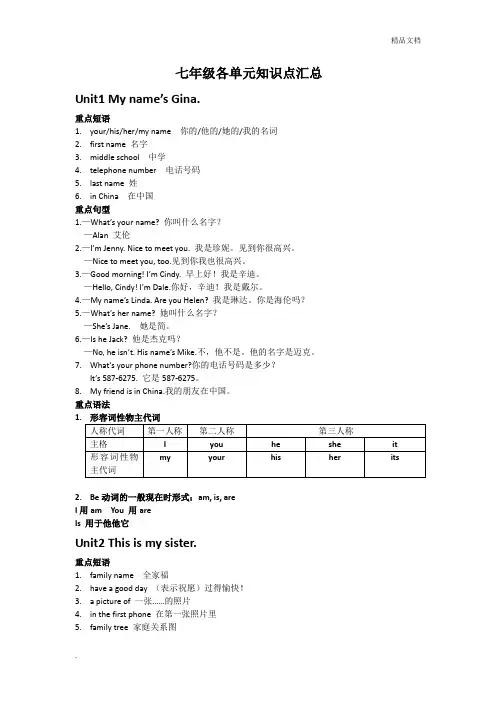
七年级各单元知识点汇总Unit1 My name’s Gina.重点短语1.your/his/her/my name 你的/他的/她的/我的名词2.first name 名字3.middle school 中学4.telephone number 电话号码st name 姓6.in China 在中国重点句型1.—What’s your name? 你叫什么名字?—Alan 艾伦2.—I’m Jenny. Nice to meet you. 我是珍妮。
见到你很高兴。
—Nice to meet you, too.见到你我也很高兴。
3.—Good morning! I’m Cindy. 早上好!我是辛迪。
—Hello, Cindy! I’m Dale.你好,辛迪!我是戴尔。
4.—My name’s Linda. Are you Helen? 我是琳达。
你是海伦吗?5.—What’s her name? 她叫什么名字?—She’s Jane. 她是简。
6.—Is he Jack? 他是杰克吗?—No, he isn’t. His name’s Mike.不,他不是。
他的名字是迈克。
7.What’s your phone number?你的电话号码是多少?It’s 587-6275. 它是587-6275。
8.My friend is in China.我的朋友在中国。
重点语法1.2.Be动词的一般现在时形式:am, is, areI用am You 用areIs 用于他他它Unit2 This is my sister.重点短语1.family name 全家福2.have a good day (表示祝愿)过得愉快!3. a picture of 一张……的照片4.in the first phone 在第一张照片里5.family tree 家庭关系图6.the name of…………的名字重点句型1.That’s my family. Those are my parents. 那是我的家人,那是我的妹妹。
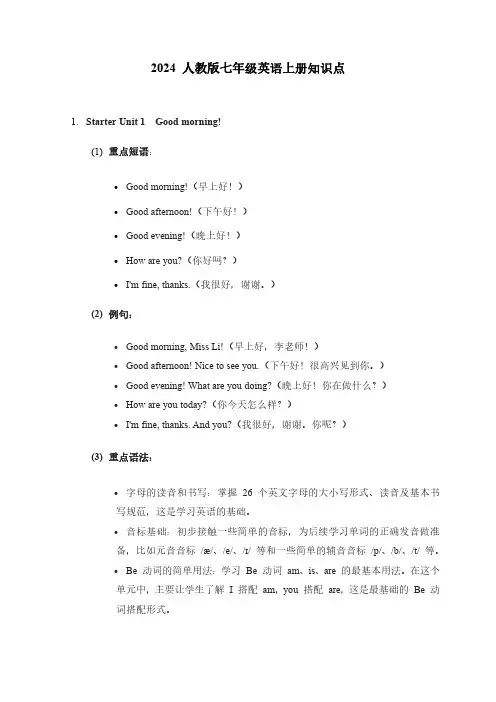
2024人教版七年级英语上册知识点1.Starter Unit1Good morning!(1)重点短语:∙Good morning!(早上好!)∙Good afternoon!(下午好!)∙Good evening!(晚上好!)∙How are you?(你好吗?)∙I'm fine,thanks.(我很好,谢谢。
)(2)例句:∙Good morning,Miss Li!(早上好,李老师!)∙Good afternoon!Nice to see you.(下午好!很高兴见到你。
)∙Good evening!What are you doing?(晚上好!你在做什么?)∙How are you today?(你今天怎么样?)∙I'm fine,thanks.And you?(我很好,谢谢。
你呢?)(3)重点语法:∙字母的读音和书写:掌握26个英文字母的大小写形式、读音及基本书写规范,这是学习英语的基础。
∙音标基础:初步接触一些简单的音标,为后续学习单词的正确发音做准备,比如元音音标/æ/、/e/、/ɪ/等和一些简单的辅音音标/p/、/b/、/t/等。
∙Be动词的简单用法:学习Be动词am、is、are的最基本用法。
在这个单元中,主要让学生了解I搭配am,you搭配are,这是最基础的Be动词搭配形式。
2.Starter Unit2What's this in English?:(1)重点单词:map(地图)cup(杯子)ruler(尺子)pen(钢笔)orange(橙子)jacket(夹克衫)key(钥匙)quilt(被子)what(什么)in(在……里)English(英语;英文)。
(2)重点短语:∙询问物品:What's this in English?(这个用英语怎么说?)、What's that inEnglish?(那个用英语怎么说?)∙回答方式:It's a/an...(它是一个……)。
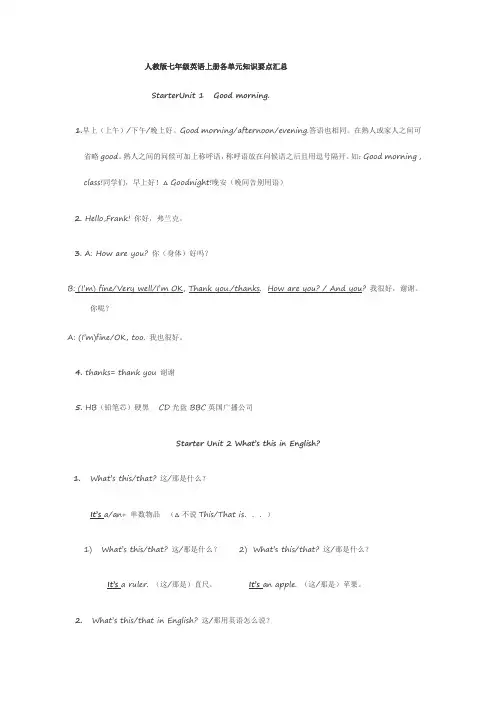
人教版七年级英语上册各单元知识要点汇总StarterUnit 1 Good morning.1.早上(上午)/下午/晚上好。
Goodmorning/afternoon/evening.答语也相同。
在熟人或家人之间可省略good。
熟人之间的问候可加上称呼语,称呼语放在问候语之后且用逗号隔开。
如:Goodmorning , class!同学们,早上好!△Goodnight!晚安(晚间告别用语)2. Hello,Frank! 你好,弗兰克。
3. A: How are you? 你(身体)好吗?B: (I‘m) fine/Very well/I‘m OK, Thank you./thanks. How areyou? / And you? 我很好,谢谢。
你呢?A: (I‘m)fine/OK, too. 我也很好。
4. thanks= thank you 谢谢5. HB(铅笔芯)硬黑CD光盘 BBC英国广播公司Starter Unit 2 What’s this inEnglish?1.What‘s this/that? 这/那是什么?It’s a/an+ 单数物品(△不说This/That is...)1) What‘s this/that? 这/那是什么?2) What‘s this/that? 这/那是什么?It’s aruler. (这/那是)直尺。
It’s an apple. (这/那是)苹果。
2.What‘s this/that in English? 这/那用英语怎么说?It’s a/an + 单数物品(△不说This/That is...)What‘sthis in English? 这用英语怎么说?It‘sa jacket. 夹克衫What‘sthat in English? 那用英语怎么说?It‘san orange. 橘子。
in + 语言:用某种语言 in Chinese/English/Japanese用汉/英/日语英语中还可用What‘s the English for….?表达同样的含义。
人教版七年级英语上册各单元重难点知识归纳UNIT 1 You and MeSECTION A How do we get to know each other?重点单词1. full adj. 完整的;满的2. grade n. 年级;等级3. classmate n. 同班同学4. mistake n. 错误;失误5. country n. 国家6. same adj. 相同的7. twin n. 双胞胎之一;adj. 双胞胎之一的8. both adj. & pron. 两个;两个都9. band n. 乐队10. pot n. 锅11. tofu n. 豆腐词形变换1. full →empty (反义词)2. classmate →classmates (复数形式)3. mistake →mistakes (复数形式)4. country →countries (复数形式)5. same →different (反义词)6. twin →twins (复数形式)7. one →first (序数词)8. China →Chinese (形容词)重点短语1. make friends 交朋友2. get to know 认识;了解3. each other 互相;彼此4. how old 多大年纪;几岁了5. full name 全名6. last name 姓氏7. be from 来自8. in Class 1, Grade 7 在七年级一班9. class teacher 班主任10. first name 名字11. a lot /very much 很;非常12. hot pot 火锅13. personal information 个人信息14. pet cat 宠物猫15. in the school band 在学校乐队16. Chinese food 中国食物17. in the same class 在相同的班18. live with 和……一起住19. Mapo tofu 麻婆豆腐重点句型1. —How old are you? 你多大了?—I'm 12 years old.我十二岁。
七年级上册Unit1-7一. 考点归纳1. Hello, Gina. Good morning. 嗨,吉娜。
早上好。
英文中常用的问候语及其答复:-Hello. -Hello.―Hi. ―Hi.―Good morning. ―Good morning.―Good afternoon. ―Good afternoon.―Good evening. ―Good evening.―Good night. ―Good night.晚安。
〔晚上分别时〕―How do you do? 你好。
〔初次见面时互相问好〕―How do you do? 你好。
―How are you? 你好吗?〔已相识者问对方好?〕―Fine, thank you.好,谢谢。
2. Sorry, I’m late. 对不起,我迟到了。
sorry “对不起” 用于引出某一过错。
Excuse me. “对不起” 用于引起对方的注意。
例如:1〕I’m sorry I can’t speak English.对不起,我不会说英语。
2〕Excuse me, is this your backpack?打搅一下,这是你的背包吗?3. Nice to meet you! 很高兴认识你!--Nice to meet you, too!4. What’s this in English? 这个用英语怎么说?1) 同义句:What’s the English for this?2) 用什么语言,介词用in: “in + 某种语言”. 例如:in English 用英语in Chinese 用汉语in Japanese 用日语5. Let’s learn English. 让我们学英语。
〔一〕let’s = let us 让我们Let’s learn English.让我们学习英语吧。
= Why not learn English?为什么不学习英语呢?= What/How about learning English? 学习英语怎么样?为什么不:why not +do; why don’t you〔二〕let sb. do sth. 让某人做某事例如:Let me play the guitar.注意:1〕let sb. do sth. 中的sb.假设是代词要用宾格形式。
人教版英语七年级上册所有单元知识点总结3.This is a picture of my family.这是我们全家的照片。
4.In the first photo。
this is my father and this is my XXX.在第一张照片里,这是我的父亲,这是我的母亲。
5.This is my family tree.这是我们的家庭关系图。
6.What’s the name of your sister?你妹妹叫什么名字?重点语法1.名词所有格的使用2.人称代词的宾格形式:me。
you。
him。
her。
it。
us。
them3.指示代词this和these的用法Unit3 Is this your pencil?重点短语1.XXX用品2.in the pencil box在铅笔盒里3.a yellow ruler一个黄色的尺子4.on XXX在桌子上5.a blue pen一个蓝色的笔6.under XXX在椅子下面重点句型1.Is this your pencil?这是你的铅笔吗?2.Yes。
it is.是的,是我的。
3.No。
it isn’t.不,不是我的。
4.What’s this in English?这个用英语怎么说?5.It’XXX.这是一个铅笔盒。
6.Where is my pen?我的笔在哪里?7.It’s under the chair.在椅子下面。
重点语法1.名词的单数和复数形式2.物主代词的宾格形式:mine。
yours。
his。
hers。
its。
ours。
theirs3.介词in。
on。
under的用法Unit4 Where are you from?重点短语1.countries国家2.capital city首都nguages语言4.be from来自5.live in居住在6.a map of一张……的地图重点句型1.Where are you from?你来自哪里?2.I’m from Canada.我来自加拿大。
Starter Unit1Good Morning! Units1—3【重点单词】good/gud/adj.好的morning/'mɔ:niŋ/n.早晨;上午Good morning!早上好!hi/hai/interj.(用于打招呼)嗨;喂hello/hə'ləu/interj.你好;喂afternoon/,a:ftə'nu:n/n.下午Good afternoon!下午好!evening/'i:vniŋ/n.晚上;傍晚Good evening!晚上好!how/hau/adv.怎样;如何are/a:/v.是you/ju:/pron.你;你们How are you?你好吗?I/ai/pron.我am/æm/v.是fine/fain/adj.健康的;美好的thanks/θæŋks/interj.&n.感谢;谢谢OK/əu'kei/interj.&adv.好;可以what/wɔt/pron.&adj.什么is/iz/v.是this/ðis/pron.这;这个in/in/prep.(表示使用语言、材料等)用;以English/'iŋgliʃ/n.英语adj.英格兰的;英语的in English用英语map/mæp/n.地图cup/kʌp/n.杯子ruler/'ru:lə/n.尺;直尺pen/pen/n.笔;钢笔orange/'ɔrindʒ/n.橙子jacket/'dʒækit/n.夹克衫;短上衣key/ki:/n.钥匙quilt/kwilt/n.被子;床罩it/it/pron.它a/ə/art.(用于单数可数名词前)一(人、事、物) that/ðæt/pron.那;那个spell/spel/v.用字母拼;拼写please/pli:z/interj.(用于客气地请求或吩咐)请color/'kʌlə/n.(=colour)颜色red/red/adj.&n.红色(的)yellow/'jeləu/adj.&n.黄色(的)green/gri:n/adj.&n.绿色(的)blue/blu:/adj.&n.蓝色(的)black/blæk/adj.&n.黑色(的)white/wait/adj.&n.白色(的)purple/'pə:pl/adj.&n.紫色(的)brown/braun/adj.&n.棕色(的);褐色(的)the/ði;ðə/art.指已提到或易领会到的人或事now/nau/adv.现在;目前see/si:/v.理解;明白can/kæn/modal v.能;会say/sei/v.说;讲my/mai/pron.我的知识点:1.短语归纳:good morning早上好good afternoon下午好good evening晚上好name list名单an English name英文名字2.必背典句:(1)Good morning,Alice!早上好,艾丽斯!(2)Good afternoon!下午好!(3)Hi,Bob!你好,鲍勃!(4)Hello,Frank!你好,弗兰克!(5)Good evening晚上好!(6)—How are you?你好吗?—I’m fine,thanks.How are you?我很好,谢谢。
人教版七年级初一英语上册复习各单元知识点归纳总结人教版七年级英语上册复习各单元知识点总结一、字母学习1.英语中共有26个字母。
其中的Aa,Ee,Ii,Oo,Uu5个字母被称为元音字母。
这五个元音字母是构成英语成千上万单词的核心,除了一些缩略词之外,其它任何一个英语单词,通常都应包含一个或多个元音字母。
26个字母中的其它21个字母被称为辅音字母。
2.字母书写的规格斜度:每个字母都要稍向右斜约10°左右,斜度要一致。
大写字母的书写规格是:上不顶天下立地。
即笔画的上端稍离第一线,笔画的下端必须紧贴第三线,不许离线也不许出格。
占中间格的小写字母有a,c,e,m,n,o,r,s,u,v,w,x,z13个,它们笔画的上端必须紧贴第二线,下端必须紧贴第三线,不许离线也不许出格。
占一格、二格的小写字母有b,d,h,k,l共5个,它们笔画的上端必须顶第一线,下端必须顶第三线,不许离线也不许出格。
小写字母i和t也占一格、二格。
但t的上端在第一格中间,短横重合第二线;i的小圆点在第一格中间稍偏下处。
占二格、三格的小写字母有g,q,y3个,它们的笔画的顶端要紧贴第二线,下端要紧贴第四线,不可离线也不可出格。
占一格、二格、三格的小写字母有f,j,p3个。
其中f的上端稍离第一线(和大写字母一样),下端紧贴第四线,短横重合第二线;j的小圆点与i的小圆点位置相同,下面一笔的上端顶第二线,下端紧贴第四线;p的上端略高于第二线,约占第一格的三分之一,下端紧贴第四线。
字母按所含音素归类表:/ei/字母:AaHhJjKk音标:[ei][eitʃ][dʒei][kei]/i:/字母:BbCcDdEeGgPpTtVv音标:[bi:][si:][di:][i:][dʒi:][pi:][ti:][vi:]/ai/字母:IiYy音标:[ai][wai]/əʊ/Oo/əʊ//ju:/字母:UuQqWw音标:/ju://kju://`dΛblju://ɑ:/Rr/ɑ://e/字母:FfLlMmNnSsXxZz音标:/ef//el//em//en//es//eks//zed/3.缩写词:HK香港ID身份PE体育课PRC中华人民共和国RMB人民币PLA中国人民解放军CCP中国共产党IOC国际奥林匹克委员会am上午pm下午cm厘米mm毫米4.英语句子的书写句子开头的第一个单词的第一个字母要大写,单词与单词之间要有适当的距离,一般为放入一个字母的空隙,句末要有标点符号,英语的句号是个实心圆点,而不是汉语中的小圆圈。
新人教版七年级英语上册知识点总结一、Starter Units 1 - 3知识点。
1. 字母。
- 26个英文字母的大小写书写形式、占格及读音。
大写字母一般占上两格,如A、B等;小写字母占格情况不同,如a、c占中间一格,b、d占上两格,g、p、q占下两格等。
- 字母的分类:元音字母(a, e, i, o, u)和辅音字母(除元音字母外的其他字母)。
2. 单词。
- 常见的问候语单词:hello(你好),hi(嗨),good(好的),morning(早晨),afternoon(下午),evening(晚上)。
- 颜色类单词:red(红色),blue(蓝色),green(绿色),black(黑色),white(白色),yellow(黄色)等。
- 文具类单词:pen(钢笔),pencil(铅笔),ruler(尺子),eraser(橡皮),crayon(蜡笔)等。
3. 句型。
- 问候语:- - Hello, Frank! - Hello, Eric!- - Good morning! - Good morning!- - How are you? - I'm fine, thank you. And you? - I'm OK.- 介绍颜色:- - What color is it? - It's red.- 询问物品:- - What's this in English? - It's a pen.二、Unit 1 My name's Gina.知识点。
1. 单词。
- name(名字),nice(美好的),to(不定式符号,无实义),meet(遇见),too(也),your(你的;你们的),his(他的),her(她的)。
- 名字相关:first name(名),last name(姓),例如:Gina Green中,Gina是first name,Green是last name。
七年级上册英语复习学英语真好玩,一百符号要记全;字母共计五十二,大写、小写各一半;音标共计四十八,元音二十,辅音二十八;学英语,很容易,听说读写和翻译;多模仿,多记忆,早读晚听别忘记;只要坚持有毅力,考试定能取得好成绩;理想大学属于你,将来必定成大器。
在初中各门学科中,英语是最容易两极分化的学科,而词汇学习是学生学英语的一道“门槛”。
可以说如果学生学会了如何记忆单词,那么,他就掌握了学习英语特别有利的途径。
许多学生因为词汇量小,看不懂课本,听不懂录音,听不懂老师讲课,一些练习无法做,从而丧失了学习英语的兴趣和信心。
因而要多运用音标等多种途经加强对单词的识记至关重要。
一、七年级字母教学资料1.英语中共有26个字母。
其中的Aa,Ee,Ii,Oo,Uu 5个字母被称为元音字母。
这五个元音字母是构成英语成千上万单词的核心,除了一些缩略词之外,其它任何一个英语单词,通常都应包含一个或多个元音字母。
26个字母中的其它21个字母被称为辅音字母。
2.字母书写的规格①斜度:每个字母都要稍向右斜约10°左右,斜度要一致。
②大写字母的书写规格是:上不顶天下立地。
即笔画的上端稍离第一线,笔画的下端必须紧贴第三线,不许离线也不许出格。
③占中间格的小写字母有a, c, e, m, n, o, r, s, u, v, w, x, z 13个,它们笔画的上端必须紧贴第二线,下端必须紧贴第三线,不许离线也不许出格。
④占一格、二格的小写字母有b, d, h, k, l共5个,它们笔画的上端必须顶第一线,下端必须顶第三线,不许离线也不许出格。
⑤小写字母i和t也占一格、二格。
但t的上端在第一格中间,短横重合第二线;i的小圆点在第一格中间稍偏下处。
⑥占二格、三格的小写字母有g, q, y 3个,它们的笔画的顶端要紧贴第二线,下端要紧贴第四线,不可离线也不可出格。
⑦占一格、二格、三格的小写字母有f, j, p 3个。
其中f的上端稍离第一线(和大写字母一样),下端紧贴第四线,短横重合第二线;j的小圆点与i的小圆点位置相同,下面一笔的上端顶第二线,下端紧贴第四线;p的上端略高于第二线,约占第一格的三分之一,下端紧贴第四线。
⑧字母按所含音素归类表:3.缩写词:HK香港ID身份PE体育课PRC 中华人民共和国RMB 人民币PLA中国人民解放军CCP中国共产党IOC国际奥林匹克委员会am 上午pm下午cm厘米mm毫米4.英语句子的书写句子开头的第一个单词的第一个字母要大写,单词与单词之间要有适当的距离,一般为放入一个字母的空隙,句末要有标点符号,英语的句号是个实心圆点,而不是汉语中的小圆圈。
5..大写字母的用法1)英语句子开头的第一个字母必须大写。
2)I(我),OK在句中任何位置都大写。
3)人名、地名、国名、某国人或某种语言等专有名词的第一个字母必须大写。
4)电影名、书名、报刊、文章的标题等中的每个实词(如:名词、动词、形容词、副词、数词)的第一个字母一般大写。
English Weekly《英语周报》Titanic《泰坦尼克号》5)表示月份、星期、重要节日的名词的第一个字母必须大写。
6)某些缩略词的第一个字母都必须大写。
7)表示称呼的名词的第一个字母通常要大写。
Uncle Wang王叔叔二、英语国际音标表(48个)[][][i][][][u][][][i][i][][u][][au][][][][][]三、区别元音字母Aa,Ee,Ii,Oo,Uu与元音二十个音素。
不定冠词a放在辅音开头的词前;an放在元音开头的词前。
大多数元音字母开头的词,一般发元音,但有些就不是,如字母Uu, 单词useful, university, European 等。
一般辅音字母开头的词发辅音,但有些就不是,如hour, honest这两个单词中h都不发音。
如:1) an Aa / Ee / Ii / Oo, an Ll / Ss / Xx / Rran orange/apple/egg/ English teacher/ eraser / ID card/ 11-year-old boy;an hour [′aʊə] 一小时,an honest man一个诚实的人(这儿的h不发音)an 8-year-old boy 一位八岁的男孩an egg an eraser2) a Uu/ Bb / Pp a useful [′jU:sful]book一本有用的书(这儿u第一个音发/ j/)a university[ju::nɪ′vɜ:sɪtɪ] 一座大学a European[′ju:rəpɪən] man 一位欧州人如:There is an “r” and a “u”in the word “ruler”.He is an English teacher. He’ll be back in half an hour.I eat an apple and a pear every day.四.词类五.英语句子成分:组成句子的各个部分即句子成分。
句子成分包括:主语、谓语、宾语、表语、定语、状语、补足语等。
一、主语(subject): 句子说明的人或事物。
1.The sun rises in the east.太阳从东方升起。
(名词)2.He likes dancing.他喜欢跳舞。
(代词)3.Twenty years is a short time in history. 二十年在历史中是个很短的时间。
(数词)4.Seeing is believing.眼见为实。
(动名词)5.To see is to believe. 眼见为实。
(不定式)6.What he needs is a book. 他所需要的是本书(主语从句)二、谓语(predicate): 说明主语的动作、状态和特征。
1.We study English. 我们学习英语2. He is asleep. 他睡着了。
三、表语(predicative):表示主语“是什么”或者“怎么样”,表语前面的动词称为系动词。
1. He is a teacher.他是个老师(名词2. Five and five is ten.五加五等于十(数词)3.He is asleep.他睡着了(形容词)4.His father is in. 他的父亲在家(副词)5.The picture is on the wall.画在墙上。
(介词短语)6.That sounds good 那听起来很好。
7.Tom looks thin. 汤姆看上去很瘦。
常见的系动词有: be, sound(听起来), look(看起来), feel(摸起来,smell(闻起来), taste (尝起来、吃起来), feel(感觉)...四、宾语:动作、行为的对象1.I like China.我喜欢中国。
(名词)2.You can help me. 你能帮助我。
(代词)3.How many do you need? We need two. 你们需要多少?我们需要两个。
(数词)4. I like playing soccer. 我喜欢踢足球。
(动名词)5.I want to have an apple. 我想要吃个苹果。
(不定式)6.Did you write down what he said? 你写下他所说的话了吗?(宾语从句)双宾语-----间接宾语(指人)和直接宾语(指物)Tom’s mother buy him some books.汤姆的妈妈给他买了一些书。
五、宾补:对宾语的补充,全称为宾语补足语。
1.We elected him monitor. 我们选他当班长(名词)2.We will make them happy. 我们将让他们高兴。
(形容词)3. We found nobody in . 我们发现没人在里面。
( 副词 )4.His father help him to do his homework . 他的父亲帮他做家庭作业。
(带to 不定式) 六、定语:修饰名词或代词的词、词组或句子。
1. He is a Chinese teacher. 他是个语文老师。
(名词) 2. He is our friend. 他是我们的朋友。
(代词) 3. I have three books. 我有三本书。
(数词) 4. He is a good student. 他是个好学生。
(形容词)5.The boy in red is my brother. 穿红衣服的男孩是我的弟弟。
(介词短语)七、状语:用来修饰动词、形容词、副词或 句子。
表示行为发生的时间、地点、原因、目的、结果、程度、条件、方式等。
1.I go to school at seven o’clock. 我在七点钟上学。
2.He reads the book in the room.他在房间里看书。
3.I don’t like thrillers because they are scary. 我不喜欢恐怖片因为它们太吓人了。
Starter Unit 1 Good morning.1.早上(上午)/下午/晚上好。
Good morning/afternoon/evening.答语也相同。
在熟人或家人之间可省略good 。
熟人之间的问候可加上称呼语,称呼语放在问候语之后且用逗号隔开。
如:Good morning , class!同学们,早上好!△Good night!晚安(晚间告别用语)2. Hello, Frank! 你好,弗兰克。
3. A: How are you? 你(身体)好吗?B: (I’m) fine/Very well/I’m OK, Thank you./thanks. How are you? / And you? 我很好,谢谢。
你呢?A: (I’m)fine/OK, too. 我也很好。
4. thanks = thank you 谢谢5. HB (铅笔芯)硬黑 CD 光盘 BBC 英国广播公司Starter Unit 2 What’s this in English?1. What’s this/that?这/那是什么? It’s a/an + 单数物品 (△不说This/That is ...)1) 这/那是什么? 2) 这/那是什么?(这/那是)直尺。
(这/那是)苹果。
2. 这/It’s a/an + 单数物品 (△不说This/That is ...)What’s this in English? 这用英语怎么说?It ’s a jacket. 夹克衫 What’s that in English? 那用英语怎么说?It ’s an orange. 橘子。